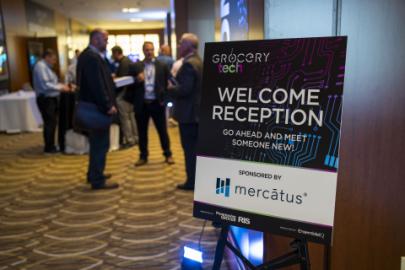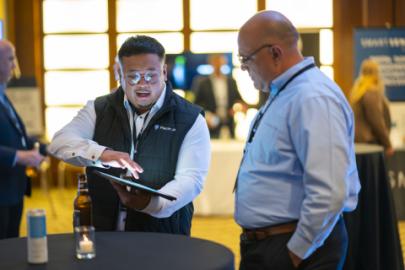The First Annual GroceryTech Conference Dives Into Scaling With Personalization, Captivating Grocery and Technology Executives

GroceryTech 2023 marks the first time the Progressive Grocer and RIS News communities came together to ponder the next evolution of the grocery industry.
With a theme of Scaling With Personalization, the synergy and excitement amongst grocery and technology executives in attendance was palpable. Brands RIS News and PG of EnsembleIQ hosted captivating and timely sessions on personalization, technology transformation, customer experience, artificial intelligence, automation, and more.
For those who missed the event or want a refresh on some of the significant topics discussed throughout these three days, we’re excited to provide highlights from all sessions below, with links to some of our expanded coverage.
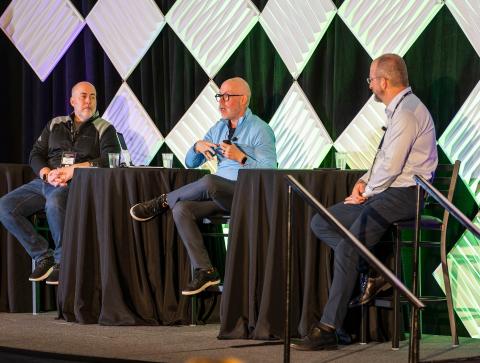
The opening day of GroceryTech kicked off with an interactive workshop hosted by Sylvain Perrier, president and CEO of grocery e-commerce provider Mercatus; Mark Fairhurst, the company's chief growth officer; and Steve Benteau, its chief technology officer.
"We're constantly looking at how we can marry the online with the mobile with the in-store, and constantly re-envisioning how we do that," Fairhurst said at the session's outset.
The Mercatus executives revealed research conducted for the company by Brick Meets Click that led them to predict that by 2027, grocery pickup would be the dominant receiving method for online grocery since it offers more control for retailers and is cheaper.
Benteau pointed out that "there's a new Mount Everest that comes into play when we start talking omnichannel," with the significant challenge being "how do you make that data integrated and consistent across the whole ecosystem?" Generative AI emerged as a critical technology enabling a more personalized e-commerce experience during the session.
In response to an audience member's question about capturing impulse purchases online, Perrier spoke of a box featuring three or four recommended items that Mercatus had placed at checkout to spur such last-minute purchases. "This is a question that everyone's trying to solve," he admitted. "How do you create the magazine/gum rack at checkout … in an online world?"
There may not always have been a definitive answer to every question, but Mercatus certainly had attendees thinking more deeply about the various issues relating to their e-commerce operations.
Read the extended coverage here

Share Group
Accelerating Innovation and Achieving Omnipresence
A host of grocery technology executives and leaders gathered for a powerful closed-door share group led by Verizon to explore how tomorrow’s successful grocers will be those who innovate swiftly and achieve a powerful omnichannel presence today.
During the closed-door session, attendees joined this collaborative share group to learn about responding to ever-changing consumer preferences, hear case studies of companies that have successfully brought innovative strategies back to their organizations, and share what their own companies are doing. The share backs inspired the room with a roundup of how innovative the participating grocers have been within their organizations.
Keynote: Scaling With Personalization

Jody Kalmbach, Kroger's group vice president of product experience, had the honor of opening up day two, the primary day of the first-ever GroceryTech event. She kicked off her keynote session, noting that she started her career in marketing, but when she joined Amazon, it was a "pivotal point" for her where she moved from marketing roles to product. "So I made this pivot, and as soon as I got caught on, what is product, what does it mean? And started this cycle of building experiences, building capabilities that were really making a difference… that was it for me."
In a fireside chat with Progressive Grocer editor-in-chief Gina Acosta, Kalmbach went on to reveal her core principles of product include shifting from being output driven to being outcome-driven, using data to understand the impact of what you're doing, and reusability—removing redundancy in the tech you're building.
"And, and maybe that's not the perfect word for it (reusability), but I would think many of you in this room can understand a situation where you have disparate technology teams building solutions that are all kind of doing the same thing right? So then you end up with all this redundancy."
She noted this is a non-starter and not a path to success. "Build it once and have it have benefits across many, many business problems."
Read the expanded coverage here
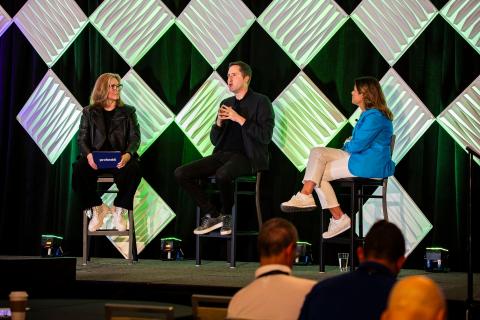
Creating Next-Gen Customer Experiences
The grocery shopping journey is making its way towards a seamless experience powered by data, algorithms, and artificial intelligence deployed for the benefit of shoppers and associates alike, according to panelists featured at the recent GroceryTech event in Cincinnati. They spoke on the show's second day during a session on "Creating Next-Gen Customer Experiences."
Presenter David McIntosh, VP and general manager of connected stores at Instacart, told the audience that a single mode that works well together to deliver perfect in-store and online experiences is on the horizon. He noted that Instacart had accelerated its capabilities to provide frictionless shopping through acquisitions of providers and platforms such as Caper Cart, FoodStorm, Rosie, and Eversight, which are now part of a suite to help shoppers find what they want when they want it.
He shared the example of the Caper Cart, an AI-powered smart cart that recognizes items for automatic checkout and provides running totals to help shoppers stick to their budgets. "The second element of the cart that is equally powerful is the screen that is in front of the customers, which is an opportunity to captivate them for the 40 or 45 minutes that they are spending at the store," he said. "With that screen, you can start to integrate personalization."
Fellow panelist Jody Kalmbach, group vice president of product experience for The Kroger Co., underscored nuances within the fused digital and physical marketplace. "Omnichannel is, by definition bringing multiple channels together so customers can shop online and in-store. It is very functional and utilitarian. Seamless is about how you make customers feel – you deliver an experience on their terms and remove friction," she explained. Relevant data, diversity of internal mindsets, and the use of AI can help grocers achieve such seamless retailing, she added.
Moderator Pam Dillon, CEO, and co-founder of adult beverage recommendation platform Preferabli, said some parts of the "next-gen" are already evident. "As I'm reflecting now in the context of this discussion, I think all roads have sort of come together. You know, neither one is more or less important," she observed.
Read the expanded coverage here
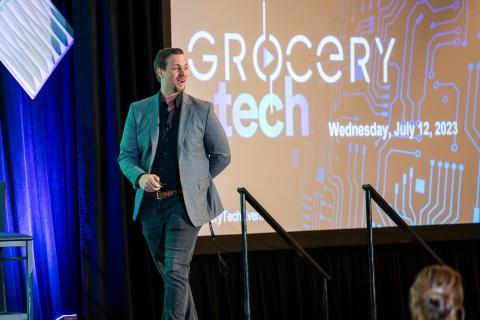
Optimizing the Customer Experience With Gen AI
John O’Reilly, head of retail, food, drug, and mass at Google Cloud, hosted this session, during which he endeavored to explain this emerging technology to food retailers, noting that 96% of C-level executives “recognize that generative AI will soon become critical to the success of any organization.”
During his presentation, O’Reilly put forth various use cases for generative AI in the grocery channel across the realms of consumer and customer experience, associate and store operations, the supply chain and sustainability, merchandising and alternative revenue, and product innovation. Google makes these happen through its various portfolio solutions built on the Google Cloud infrastructure. O’Reilly also mentioned Google’s partnership with French supermarket chain Carrefour on a generative AI-powered marketing studio poised “to revolutionize productivity and collaboration.”
Regarding the Carrefour project, he asked his audience to “think about Twitter posts, blog posts, being able to quickly generate images, all of the copy, all of the titles. And if you start thinking about co-branded content, personalized content, and the number of different ways in which you can create different types of content. Eventually, the bottleneck becomes the designers, the copywriters, and the marketing team. [With generative AI,] that’s no longer a bottleneck, and that’s the power of these large-language models.”

Shaping the Future of Food by Building an AI/ML Strategy
Jamie Hemmings, one of the panelists in this July 13 session moderated by EnsembleIQ's chief retail analyst Elizabeth LaFontaine, shared some succinct advice for grocers mulling over AI and ML: "Don't be afraid to get in this space."
Hemmings, president and founder of Nourish + Bloom Market in Fayetteville, Ga., spoke alongside Jilea Hemmings, the company's CEO and founder, and fellow panelist Alexa Dash, director of e-commerce for Dash's Markets in Buffalo, N.Y. While the presenters come from different formats – Nourish + Bloom Market started just a few years ago, and Dash's is a century-old grocer -- all three emphasized the benefits of AI and ML capabilities in meeting consumers where they are, growing business opportunities, and supporting communities.
Jilea Hemmings said Nourish + Bloom customers who can shop autonomously 24/7 have become accustomed to and appreciative of that model: "There was a huge learning curve because they were used to traditional checkout, and didn't understand that now there are cameras in the ceiling, there no lines and you just walk out, and everything is paid for. But we have found that we have been able to introduce our community to this level of the shopping experience, and they really are embracing the technology and love the flexibility that it brings," she reported.
Dash agreed that opportunities open up with grocery technologies like AI and ML, which have been in place in the industry longer than consumers may realize. "We have customers who live far away but come to us for holiday shops. We can now serve them targeted ads to let them know they can get food from us every day of the week," she said, adding that frictionless experiences have helped the retailer and its customers learn together.
These entrepreneurial grocers pointed out that grocery tech can help customers in many ways, from helping those with autism experience a store virtually with a VR headset to assisting blind patients using voice activation in a location. Nourish + Bloom hosted a STEM camp for children showcasing the potential of retail technologies. "We've changed so many of these children's minds about technology and what they can do with it," said Jamie Hemmings. "We actually had one of the children come up to us and say, 'You know what? I think I want to do this. I think I want to build an automated grocery store.'"
Keeping Shoppers at the Center of Personalization Products

As retailers and brands work to meet shopper demand for personalized experiences, often the rush to implement new capabilities can leave the shopper's needs secondary. In the session "Keeping Shoppers at the Center of Personalization Products," Garry Church, SVP of enterprise sales, and Andy Jump, VP & GM of incentives & loyalty with Inmar Intelligence, explored the challenges and best practices for ensuring your shopper remains at the heart of your personalization ideation, product planning, and development.
Church noted that people struggle paycheck to paycheck, which should energize us to find solutions. Inmar found 60% of Americans live paycheck to paycheck, including 45% of high-income earners.
Jump took the stage and noted, "serving people is my DNA," before breaking down the three kinds of retailers when it comes to technology solutions:
- Retailers who build it alone
- The outsource everything retailer
- The hybrid, or the Goldilocks retailer
His tips to keep shoppers at the center of personalization included consistently elevating shopper feedback. "The tendency is we only ask shoppers when we have an initiative in mind." He explained we should be gathering shopper feedback with consistency. Additionally, the scope of shopper feedback is essential, and the distribution of the feedback. It's important to have partners who are also gathering and sharing information, he says.
"You don't have to be super smart." He noted that if you ask a bunch of people about products, they will tell you things, but it helps to make the feedback fun, pointing to Stichfix and Netflix as examples.
Key Themes for GroceryTech 2023

During his presentation on the second day of GroceryTech, R.J. Hottovy, head of analytical research for Placer.ai, traced current shopping trends to a critical point.
“The gas prices we saw the first week of March 2022 – that’s when we started to see a lot of behavioral changes,” he told the audience. “Consumers realized, ‘I’m paying a lot in rent, I’m paying a lot in potential health care costs.’ Gas was the straw that broke the camel’s back.”
Hottovy went on to share Placer.ai’s foot traffic data to demonstrate consumers’ shift to different store formats, including value grocery stores, dollar/discount stores, and, to some extent, convenience stores. “There’s been an ebb and flow, but there is definitely a value mindset prevailing. Affordable grocery thrives in the face of high food inflation,” he said, adding that the movement has been taking place among shoppers of varying income levels.
The focus on price is reflected in consumers’ habits once they are inside physical stores. “It’s back to mission-driven grocery shopping. The number of visits are down, but we have noticed an increase in dwell time. Part of that is trip consolidation – it’s almost universal. There is also evidence that people are spending more time looking on the shelf and price shopping,” Hottovy reported.
In his analytics-rich presentation, Hottovy also noted that while competitive pricing can bring in shoppers, it’s not enough to keep them there. “It’s that idea that we’re innovating at the value platforms, with new flavor profiles, product categories, and new ways of packaging,” he said.
He also highlighted the elevation of store brands, fueled by price-conscious shoppers and retailers’ investment in their private label portfolios. “Conventional grocers are getting back in the game on that front. Grocers like Safeway and Sprouts started expanding and doing innovation around private label, and that’s becoming apparent in visitation data, especially in the past few months,” he shared.
Hottovy emphasized the appeal of in-store shopping experiences, too. “The idea of these immersive locations – if you can improve that experience. There’s obviously a lot that goes into that,” he observed.
Other trends Hottovy toplined in his session include grocers’ investment in smaller format stores, the explosion of retail media networks, and the evolving work week, as hybrid work schedules have led to spikes in grocery visits on Tuesdays, Wednesdays, and Thursdays.
Automation, Talent, and Recruiting for a Fruitful Future

This session offered attendees insights into the intersection of technology with various labor issues. Moderated by Progressive Grocer editor-in-chief Gina Acosta, the panel featured Michael Criscuolo, VP of infrastructure and operations at Wakefern Food Corp; Rana Schiff, senior director, HR business partner, technology and digital at The Kroger; Co. and Victor Vercammen, VP of enterprise safety and healthcare compliance at Giant Eagle.
All noted that retention was difficult in today’s labor market. To counter this trend, Criscuolo observed that Wakefern was implementing robots, which the company had dubbed “co-bots,” to help associates do their jobs faster and better, and that it was working with Axonify to offer training in easy-to-digest “microbites.” Vercammen said that Giant Eagle was similarly approaching training by breaking it into several segments so employees could get out on the floor faster. Meanwhile, Schiff spoke of Kroger’s “agile programs” that sped up training in an environment where companies “don’t have the luxury of time.”
Asked about the recruitment of Gen Z and Gen Alpha associates, Vercammen noted that those demographics in particular “want their work to matter,” adding that implementing technology to free them from low-value, non-customer-facing tasks made sense for those workers.
Ultimately, however, Schiff pointed out that what’s especially important to Kroger is whether a job candidate is “a culture fit.” As she put it, “As many skills as that person could have, we don’t really want them to join the company if that’s not where they want to be and that culture doesn’t resonate for them.”
Read the expanded coverage here.
Friday, July 14
Grocery Study Breakfast Panel

Kicking off the final morning of GroceryTech, EnsembleIQ's VP of Research Beth Brickel treated the audience to an overview of the "2023 Grocery Tech Trends Study: A Balancing Act," exclusive data not included in the study, and a panel of experts to discuss the findings.
To start, she pointed out that when grocers are asked about their tech investments, 57% of retailers expect their tech/automation spending to increase in 2023. "We've got more than half [of grocers] saying they're interested in exploring digital shelves more and getting close to that with electronic shelf labels."
When turning to the results from the shopper survey, Brickel said self-checkout leads as the most preferred method of checkout. She also noted that online shoppers are most frustrated with out-of-stocks (50%), and retailers and shoppers agree on the number one feature desired — digital discounts.
Brickel then asked the panelists questions, beginning with labor concerns around frontline workers and workforce technology.
Nick Klein, senior director of enterprise solution sales, Dematic, kicked off, noting that his experience lies with the distribution center (DC). When talking about fully automated DCs, he said, "the typical warehouse worker is intimated by that when they hear us coming. Maybe 20 years ago, that would be the case, but today, that's not the case. Automation doesn't displace jobs."
He explained that the user interface built into these systems makes it easy for the employee to operate. "They're guided to what to do next. They know exactly which product to pick, out of which box, and then which tote to put it into, step by step."
Brickel later noted that 75% of shoppers are open to trying new tech in grocery stores, "so don't be afraid to invest," but 44% are afraid of tech replacing the human team members in grocery. "How can grocers retain that human touch?"
"When you're tethered to the point of sale, you can't help customers out on the floor, right?" Jawa asked. "We're training for different skills." He noted that automation has its place, but we must find that blend and balance as consumers want a more tech-driven experience. When the staff is engaged with the tech, they train the customers to use it in the store, and tech adoption is better.
Read the extended coverage here
Get the 2023 Grocery Tech Trends Study here.
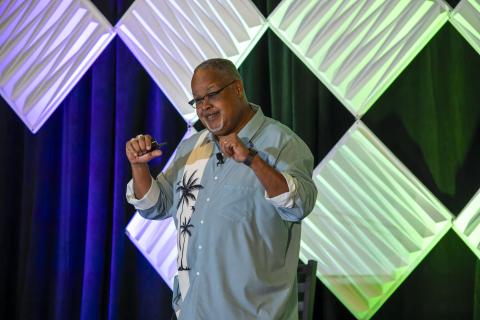
Live Commerce: The Fresh Market Stakes Its Flag in the Live Shopping Wars
Kevin Miller, the ebullient chief marketing officer at The Fresh Market, discussed how the grocer had deployed live shopping to deepen its connection with shoppers during his presentation, keeping attendees engaged with the story of how the grocer not only successfully leveraged this cutting-edge tech, but also had plenty of fun doing it.
After revitalizing its business, The Fresh Market decided to enter an emerging area of business where China had been the undisputed leader for several years. Teaming up with Firework, the grocer went all in with shoppable video, deploying the solution across its website, emails, and social channels. Buoyed by its early success, the company created 800-plus new videos in 2022, and as Miller noted: “We found that we got over 130 million views of this content. … If … your customers [are spending] that much time embracing your advertising … as they’re being entertained and informed, their engagement rate goes way up.”
The company has also implemented an AI tool on the back end of its livestreams to interact with customers and has developed its own unique approach to retail media, which Miller described as “the opportunity to be in the most immersive marketing platform ever, which is our shoppable video platform, and to share the type of results that we get with our vendor partners.”
Read the extended coverage here.

Understanding Customers Together: Retail and CPG Data Partnerships
Collaborations between retailers and CPGs are as longstanding as the first arrangement to sell products on store shelves. In today’s tech-fueled environment, those partnerships have evolved in new and robust ways to deliver what consumers want and need, a group of panelists concurred during a session on the third day of GroceryTech.
Moderator Brendan O’Brien, director of insights solutions for 84.51, underscored the “huge opportunity” of personalization and how CPGs and grocers are leaning in on insights to reach shoppers and enhance organizational profitability across an increasingly seamless marketplace.
The panelists shared a wealth of their own insights. Kate Cullen, who handles product, search, and monetization for Kroger, said that delivering customer experiences through retail/CPG collaborations and data-driven personalization makes this a dynamic era. “I am of the mindset that if you create an echo chamber, it has the ability to drive more stagnation in the consumer experience. So, for personalization, I challenge my team quite a bit to think about the context of experience. What are customers looking for, and how do you then layer in personalization on top of that?” she said.
Kim Viccaro provided her perspective as the North America data strategy lead for consumer health company Kenvue, which encompasses iconic brands like Tylenol and Listerine. “Fifty percent of my role is about data quality, and the other 50% is, ‘How do we generate value-led use cases to unlock that personalization opportunity?’’” she remarked.
Grant Shova, the PepsiCo head of e-comm for the Kroger team in Cincinnati that represents more than 80 categories, agreed that data-enabled personalization drives discovery and activations and noted that effective joint business partnerships share information and intent. “If you start with, ‘What is the problem we are trying to solve?’ and go on the journey together, it’s a pretty magical thing,” he told the audience.
The panelists weighed in on other ways to create strong partnerships, such as identifying gaps, bringing in third-party vendors when needed, and ensuring cross-functional collaborations. Among other tools, they identified collaborative cloud capabilities, curated carousels, AI, and generative AI as game-changing technologies that allow for transformative conversions and faster business impacts.

The New Customer-Centric Grocery Experience
The inaugural GroceryTech event closed with a bang, as the day’s final session explored how customers are the impetus behind the choice and use of technologies across the industry.
Marcio Ribeiro, chief digital and information officer for Dom’s Kitchen and Market, drew laughs when he noted that Dom’s, which opened its first of two locations in Chicago in 2022, is akin to a hummingbird. “We are tiny, but we are fast – we can fly backward, and people love us when they see us,” he said. Technology has helped Dom’s scale with agility from the get-go, Ribeiro reported, as the grocer offers e-commerce options that help its urban consumers solve daypart needs.
Co-presenter Kirk Ball, EVP, and chief information officer and chief technology officer at Giant Eagle, told the audience that even with a wide wingspan – or footprint, as it may be – the individual consumer is the one that technology ultimately aims to reach and impact. “We hear a lot of folks talk about personalization, but at the end of the day, it is incredibly important and starts at the local store,” he said. “So, you ask, what do the clientele shop at a given store? What do they prefer as a large group? And then how do you drill down even further to the household that shops at the store?”
Prompted by moderator Andy Walter of AJW Advisory LLC, Ball and Ribeiro emphasized other vital points in the customer-centric, tech-enabled path to purchase:
- Managing data in real-time, deriving insights, and acting on it is critical in engaging customers at the household level.
- Loyalty programs define and distinguish grocers as they engage with consumers, especially when applying technologies.
- Creative collaboration helps stakeholders avoid reinventing programs, processes, and platforms.
- Grocery tech brings the customer back into focus from a labor standpoint, as store employees can forgo more mundane tasks to help and interact with shoppers.
GroceryTech 2023: A Photo Recap
THANK YOU TO OUR SPONSORS



